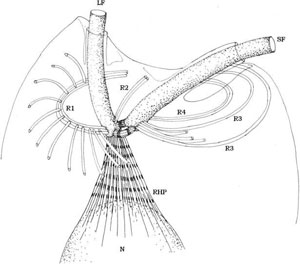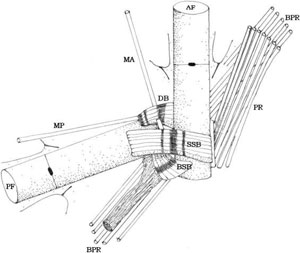Heterokontophyta
The root system will be described for each class of this division, selecting when possible a genus
representing the morphological cell type within the class.

FIGURE 2.49 Root system of Ochromonas sp. (Heterokontophyta). LF, long flagellum; SF, short flagellum; R1, R2, R3, and R4, microtubular roots; RHP, rhizoplast; and N, nucleus.
The root system of Ochromonas can be considered the basic type of the Chrysophyceae. A
single large cross-banded contractile root, termed rhizoplast, is typically present, associated with
the basal body of the longer pleuronematic flagellum. After leaving the basal body, this fibrous
root passes closely against the edge of the chloroplast and reaches the tip of the pyriform
nucleus. It then splits into several branches, ramifying over the nuclear surface, with some branches
located in the narrow space between the nucleus and the associated Golgi body. Four microtubular
roots, R1, R2, R3, and R4, anchor the two flagella in the cell, R1 and R2 are associated with the
basal body of the long pleuronematic flagellum, and R3 and R4 are associated with the basal
body of the short smooth flagellum. The three-stranded R1 describes an arc in the anterior part
of the cell just beneath the cell membrane. The two-stranded R2 originates at the opposite side
of the basal body, running along the cell membrane. R3 and R4, consisting of a species-specific
number of microtubules, arise from the opposite sides of the basal body of the short flagellum, and form a loop around and under this flagellum. R1 forms the base of attachment of numerous
microtubules running towards the posterior end of the cell, with cytoskeletal function (Figure 2.49).

FIGURE 2.49 Root system of Ochromonas sp. (Heterokontophyta). LF, long flagellum; SF, short flagellum; R1, R2, R3, and R4, microtubular roots; RHP, rhizoplast; and N, nucleus.
As yet no complete analysis of the flagellar root systems of Xanthophyceae exists. The typical
root system as presently understood appears to consist of three different types of structures: a descending root originating near the basal bodies, resembling the rhizoplast in extending from the basal bodies along the nuclear surface, between the nucleus and the Golgi body, but differing in being
unbranched, and in consisting of a succession of rectangular blocks rather than fibers as in the Chrysophyceae; a cross-banded fibrillar root composed of slightly curved bands, originating together
with, but at right angles to the descending root, and terminating at the cell membrane; microtubular
roots in various number near the basal bodies, each of which containing three or four microtubules.
In Vaucheria the system is completely different; neither a descending root nor a cross-banded fiber
are present, but its anterior protrusion is supported by a single broad microtubular root of 8–9
microtubules arranged in a row. This root originates near the base of the anterior pleuronematic
flagellum, and from here passes forward along the cell membrane to the tip of the protrusion,
turns around and runs back on the opposite side of the cell, again along the membrane.
Only few data are available on the flagellar roots of Eustigmatophyceae. Both microtubular and
cross-banded fibrillar types are present. The microtubular structures, consisting of 2–5 microtubules, arise close to the basal bodies and pass anteriorly and posteriorly in the cell. The crossbanded roots are narrow and pass from the region of the flagellar bases along the anterior flattened face of the nucleus.
The ultrastructure of the flagellar root system has been described only in one species of Bacillariophyceae, Biddulphia laevis. In the spindle-shaped spermatoids of this centric diatom a system of microtubules radiates from the only basal body present into the cell, to form a cone on the anterior part of the nucleus, and at least some of these microtubules extend throughout the length of the cell. They appear to maintain the elongated shape of the nucleus, and thus probably of the cell.
An elaborate root system connects the basal bodies to the anterior surface of the nucleus in the
Raphidophyceae. In Chattonella two or three roots have been described, one multi-layered associated
with the pleuronematic flagellum, and one with the smooth flagellum. The latter is a band of
9–10 microtubules which extends from the awnterior part of the cell, passing between the basal
bodies, and joining with other microtubules before extending along the nucleus in a depression
of its surface. A large number of distinctly cross-banded fibrous roots are also present, extending
from the flagellar bases to ensheathe the anterior cone of the nucleus.

FIGURE 2.50 Root system of Fucus sp. (Heterokontophyta). AF, anterior flagellum; PF, posterior flagellum; PR, proboscis root; BPR, bypassing microtubular root; MA, minor anterior root; MP, minor posterior root; DB, deltoid band; SSB, strap-shaped band; and BSB, button-shaped band.
In the Phaeophyceae the structure of the flagellar root system appears remarkably uniform. The
main characteristic of the system is the root supporting the flat, elastic proboscis in spermatozoids
of brown algae. In Fucus this root is very broad, contains usually 7 microtubules (but there can be
up to 15 microtubules), which travel from the base of the anterior flagellum along the plasmalemma
to the anterior end of the cell, where the proboscis is located. Here, they bend back and run along the
cell membrane on the opposite side. A bypassing microtubular root, of about five microtubules,
originates in the anterior part of the cell, runs along the proboscis root, bypasses the basal
bodies, without contact, and continues towards the posterior part of the cell. Other two minor microtubular roots, consisting of only one microtubule, are present, one extending anteriorly, the other posteriorly. The basal bodies are interlinked by three cross-banded connectives, the deltoid, the
strap-shaped, and the button-shaped bands (Figure 2.50).

FIGURE 2.50 Root system of Fucus sp. (Heterokontophyta). AF, anterior flagellum; PF, posterior flagellum; PR, proboscis root; BPR, bypassing microtubular root; MA, minor anterior root; MP, minor posterior root; DB, deltoid band; SSB, strap-shaped band; and BSB, button-shaped band.







